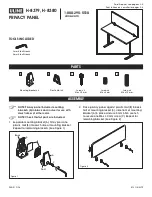
3 PDQeX Instruction Manual
201
90513
Specifications
Sample Capacity
24 samples, standard 96 well spacing
For use with
PDQeX Cartridges (200
µ
L)
Interface
5” Touch Screen (colour)
Voltage (24 V DC adapter included)
100-240 VAC, 2A, 50/60Hz
Power
96 Watts at peak draw
Thermal Profiles
Pre-installed & User Programmable
Programmable Thermal Range
34-120 C
Dimensions
22 x 18 x 18.5 cm (L x W x H)
(8.5”x 7” x 7.25”)
Weight
10.6 Lbs (4.8 kg)
Process Overview
Step 1. Sample preparation.
Sample preparation prior to extraction will vary from sample to sample.
Step 2. Cell Lysis, DNA liberation and purification.
This multi-stage process all takes place inside the disposable cartridge.
1. The cells are lysed by a cocktail of enzymes. This cocktail varies for different
substrates. For example, the lysis of leaf tissue requires a complex mixture of
hydrolases and a program on the PDQeX to activate them.
2. A temperature regimen is carried out by the hardware. This brings into play
the different enzymes at different temperatures. The final temperature
inactivates the enzyme leaving a lysate containing DNA, cell debris and
denatured protein.
3. On completion of the extraction, the tube forces the extract through a
special column. The columns are tailored to each sample type and designed
to remove anything that may inhibit
Taq
DNA polymerase or enzymes used
in most other downstream processes.
4. The samples are finally ejected into PCR tubes in a standard format (8 strips
or 3x8 strips).
The whole process takes between
7 and 20 minutes
to produce a batch of DNA
extracts.
Step 3. Quantification.
The DNA is now ready for quantification. Because the heat step denatures the DNA,
we do not advise using OD or fluorescent dye methods. The best method for
quantification is qPCR. With normalised samples, quantification is not always
required and the DNA can be used directly.
































